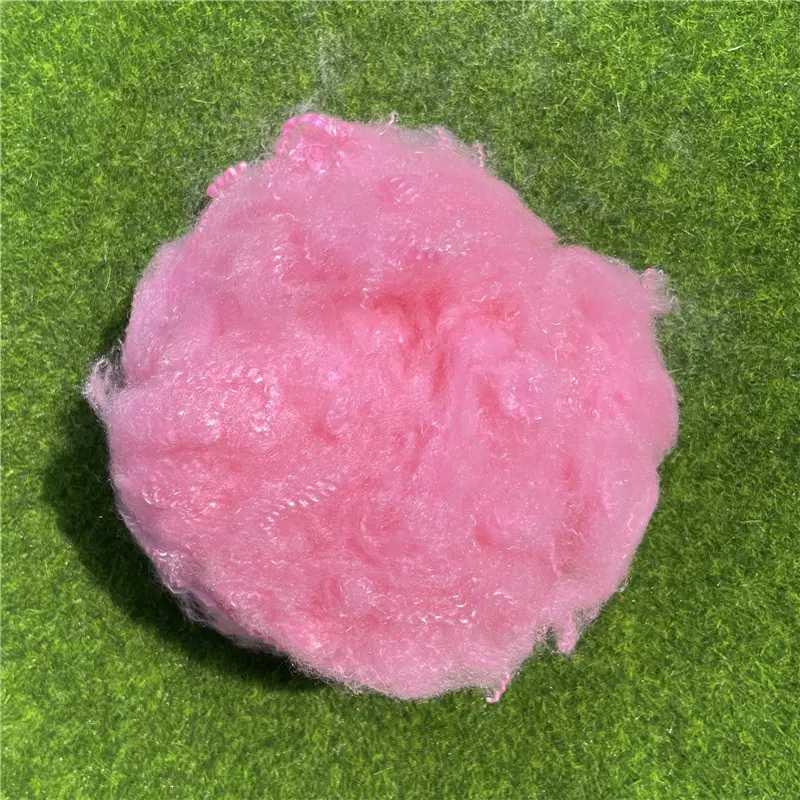In textiles, visual appeal matters as much as performance—especially outdoors or under UV. Virgin Dope Dyed Polyester Staple Fiber (PSF) offers built-in colorfastness and UV resistance by adding pigment during melt spinning.
This article examines the colorfastness and UV resistance of virgin dope dyed PSF, compares it with traditional dyed fibers, and highlights data for applications from apparel to outdoor use.

What Is Virgin Dope Dyed PSF?
Virgin Dope Dyed PSF is polyester staple fiber made from 100% virgin PET chips, with color pigments added before fiber extrusion. This means the pigment becomes part of the polymer matrix, as opposed to conventional surface dyeing, where the color is applied after fiber formation.
Key Advantages:
- Stronger bonding between pigment and polymer
- Reduced water and chemical usage
- Enhanced resistance to fading under light, washing, and environmental exposure
Section 1: Colorfastness in Virgin Dope Dyed PSF
What Is Colorfastness?
Colorfastness measures a fiber’s ability to retain its color over time and under different environmental or mechanical stresses. It includes resistance to:
- Light (UV exposure)
- Washing
- Rubbing (dry and wet crocking)
- Sweat and chemicals
Virgin dope dyed PSF is widely known for excellent colorfastness across all categories, particularly in light and wash resistance, which are critical for outdoor and high-maintenance textile applications.
Colorfastness Test Results (ISO Standards)
Below is a comparison chart of colorfastness ratings (scale: 1 = very poor, 5 = excellent):
| Test Category | Virgin Dope Dyed PSF | Conventional Dyed PSF |
| Lightfastness (ISO 105-B02) | 6–8 | 3–5 |
| Wash Fastness (ISO 105-C06) | 4–5 | 3–4 |
| Rub Fastness (Dry) | 4–5 | 3–4 |
| Rub Fastness (Wet) | 4 | 2–3 |
| Sweat Fastness (ISO 105-E04) | 4–5 | 3–4 |
Note: Ratings may vary slightly depending on pigment type, blend ratio, and fiber fineness.
Section 2: UV Resistance of Dope Dyed Virgin PSF
Why UV Resistance Matters
Prolonged exposure to sunlight can degrade textiles due to UV radiation. This leads to:
- Color fading
- Polymer degradation
- Surface cracking or brittleness
Dope dyed virgin PSF provides superior UV resistance because:
- Pigment is integrated into the polymer, offering deeper protection
- Stabilizers and UV absorbers can be added during the melt spinning process
- The uniform distribution of pigment blocks UV penetration effectively
UV Degradation Behavior: Virgin vs Conventional PSF
| Property | Virgin Dope Dyed PSF | Surface Dyed PSF |
| Color Retention (500h exposure) | >90% | <60% |
| Tensile Strength Loss (500h) | <10% | >25% |
| Surface Yellowing | Minimal | Moderate to Severe |
| Polymer Cracking | Rare | Common |
These results are typically measured after accelerated aging in Xenon arc testing chambers (ASTM G155 or ISO 105-B02 protocols).
Section 3: Advantages in Application Fields
Outdoor Textiles & Upholstery
Colorfastness to light and UV is crucial for awnings, outdoor cushions, umbrellas, and tents. Virgin dope dyed PSF maintains color vibrancy and structural integrity even under prolonged UV exposure, outperforming traditional solution-dyed and piece-dyed fibers.
Automotive Interiors
Automobile seat covers and interior trims demand high resistance to UV, abrasion, and sweat. Virgin dope dyed PSF meets the requirements of OEM standards for lightfastness (minimum grade 6) and wash fastness (minimum grade 4), making it ideal for car headliners, seat fabrics, and door trims.
Workwear and Technical Apparel
High-performance workwear in industries like oil, mining, and agriculture needs long-term durability, fade resistance, and mechanical strength. Dope dyed PSF ensures consistent color across batches and improved longevity.
Section 4: Environmental and Cost Considerations
Environmental Benefits
Conventional dyeing methods include:
- Significant volumes of chemicals and water
- Energy-intensive washing, fixing, and drying stages
- High environmental effluent load
Virgin dope dyed PSF eliminates most of this by integrating the color in the polymer melt, reducing:
- Water usage of up to 90%
- Utilizing chemicals by up to 85%
- CO₂ emissions by up to 60%
This makes it a sustainable choice for eco-friendly textile production.
Cost Efficiency Over Time
While the initial cost per kg may be slightly higher due to pigment costs and color masterbatch formulation, savings over time are significant:
- No post-dyeing process required
- Reduced energy and labor
- Less waste and reprocessing
- Better color yield and batch consistency
Section 5: Case Study – Outdoor Furniture Fabric Test
Material: 100% Virgin Dope Dyed PSF, Black, 1.4D x 38mm, spun into yarn and woven
Testing Environment: Outdoor exposure in the Arizona desert climate
Duration: 6 months
| Property | Initial Value | After 6 Months | % Retention |
| Color Luminance (CIELAB) | L* = 24.5 | L* = 26.1 | 94% |
| Tensile Strength (ASTM D5035) | 45 N | 42.5 N | 94.4% |
| Surface Appearance | Smooth | Smooth | N/A |
| UV Index Rating | 7/8 | 7/8 | No drop |
This demonstrates the robust UV stability and excellent weatherfastness of virgin dope dyed PSF.
Section 6: Limitations and Considerations
Despite its advantages, virgin dope dyed PSF has a few constraints:
Color Range Limitations
- Achieving bright or fluorescent colors is difficult
- Limited shade flexibility post-production; color must be decided during spinning
Batch-Specific Pigmentation
Each color requires a separate masterbatch, increasing cost and complexity for low-volume or multi-shade productions
Incompatibility with Some Blends
When blended with natural fibers (like cotton), overall colorfastness may drop depending on the spinning and finishing process
Section 7: Market Demand and Future Trends
The global market for dope dyed fibers is rising, driven by:
- Sustainability initiatives
- Strict environmental regulations
- Growing outdoor lifestyle and automotive sectors
Forecast Data (2025–2030)
| Region | CAGR Growth (Dope Dyed Fiber) | Key Drivers |
| North America | 6.5% | Automotive interiors, outdoor furniture |
| Europe | 5.8% | Eco-regulations, technical textiles |
| Asia-Pacific | 8.3% | Mass production, fashion, and uniforms |
Conclusion
Virgin dope dyed PSF represents a game-changing solution for industries that demand exceptional colorfastness, UV resistance, and environmental performance. By embedding pigment within the fiber, it delivers long-lasting color, high strength retention, and stable aesthetics even in harsh outdoor or industrial conditions.
Whether in automotive trims, technical garments, outdoor furnishings, or sustainable textiles, virgin dope dyed PSF offers unmatched durability under light and weather exposure—making it not just a functional material, but also a sustainable and economically sound choice.

